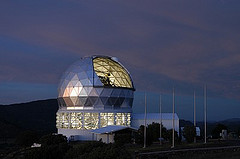
Three planets — each orbiting its own giant, dying star — have been discovered by an international research team led by a Penn State University astronomer. Using the Hobby-Eberly Telescope, the astronomers observed the planets’ parent stars — called HD 240237, BD +48 738, and HD 96127 — tens of light years away from our solar system. One of the massive, dying stars has an additional mystery object orbiting it, according to team leader Alexander Wolszczan, Evan Pugh Professor of Astronomy and Astrophysics at Penn State, who, in 1992, became the first astronomer ever to discover planets outside our solar system. The new research is expected to shed light on the evolution of planetary systems around dying stars. It also will help astronomers to understand how metal content influences the behavior of dying stars.
The research will be published in December in the Astrophysical Journal. The first author of the paper is Sara Gettel, a graduate student from Penn State’s Department of Astronomy and Astrophysics, and the paper is co-authored by three graduate students from Poland.
The three newly discovered planetary systems are more evolved than our own solar system.
“Each of the three stars is swelling and has already become a red giant — a dying star that soon will gobble up any planet that happens to be orbiting too close to it,” Wolszczan said. “While we certainly can expect a similar fate for our own Sun, which eventually will become a red giant and possibly will consume our Earth, we won’t have to worry about it happening for another 5 billion years.” Wolszczan also said that one of the massive, dying stars — BD +48 738 — is accompanied not only by an enormous, Jupiter-like planet, but also by a second, mystery object.
According to the team, this object could be another planet, a low-mass star, or — most interestingly — a brown dwarf, which is a star-like body that is intermediate in mass between the coolest stars and giant planets. “We will continue to watch this strange object and, in a few more years, we hope to be able to reveal its identity,” Wolszczan said.
The three dying stars and their accompanying planets have been particularly useful to the research team because they have helped to illuminate such ongoing mysteries as how dying stars behave depending on their metallicity. “First, we know that giant stars like HD 240237, BD +48 738, and HD 96127 are especially noisy. That is, they appear jittery, because they oscillate much more than our own, much-younger Sun. This noisiness disturbs the observation process, making it a challenge to discover any companion planets,” Wolszczan said. “Still, we persevered and we eventually were able to spot the planets orbiting each massive star.
Once Wolszczan and his team had confirmed that HD 240237, BD +48 738 and HD 96127 did indeed have planets orbiting around them, they measured the metal content of the stars and found some interesting correlations. “We found a negative correlation between a star’s metallicity and its jitteriness. It turns out that the less metal content each star had, the more noisy and jittery it was,” Wolszczan explained. “Our own Sun vibrates slightly too, but because it is much younger, its atmosphere is much less turbulent.”
Wolszczan also pointed out that, as stars swell to the red-giant stage, planetary orbits change and even intersect, and close-in planets and moons eventually get swallowed and sucked up by the dying star. For this reason, it is possible that HD 240237, BD +48 738 and HD 96127 once might have had more planets in orbit, but that these planets were consumed over time. “It’s interesting to note that, of these three newly-discovered stars, none has a planet at a distance closer than 0.6 astronomical units — that is, 0.6 the distance of the Earth to our Sun,” Wolszczan said. “It might be that 0.6 is the magic number at which any closer distance spells a planet’s demise.”
Observations of dying stars, their metal content, and how they affect the planets around them could provide clues about the fate of our own solar system. “Of course, in about 5 billion years, our Sun will become a red giant and likely will swallow up the inner planets and the planets’ accompanying moons. However, if we’re still around in, say, 1 billion to 3 billion years, we might consider taking up residence on Jupiter’s moon, Europa, for the remaining couple billion years before that happens,” Wolszczan said. “Europa is an icy wasteland and it is certainly not habitable now, but as the Sun continues to heat up and expand, our Earth will become too hot, while at the same time, Europa will melt and may spend a couple billion years in the Goldilocks zone — not to hot, not to cold — covered by vast, beautiful oceans.”
Penn State’s Center for Exoplanets and Habitable Worlds is organizing a conference in January 2012 to discuss planets and their dying stars. The conference will be held in Puerto Rico and is scheduled to take place at exactly 20 years from when Wolszczan used the 1,000-foot Arecibo radiotelescope to detect three planets orbiting a rapidly spinning neutron star — the very first discovery of planets outside our solar system. This discovery opened the door to the current intense era of planet hunting by suggesting that planet formation could be quite common throughout the universe and that planets can form around different types of stellar objects. Information about the conference is online at http://www.mpia-hd.mpg.de/PLANETS2012/index.html.
In addition to Wolszczan and Gettel at Penn State, other members of the research team include Andrzej Niedzielski, Gracjan Maciejewski, and three graduate students: Grzegorz Nowak, Monika Adamow, and Pawel Zielinski, who all are from Nicolaus Copernicus University in Torun, Poland.
Funding for this research was provided by NASA and the Polish Ministry of Science and Higher Education.
Barbara Kennedy, Penn State DuBois


